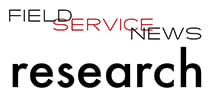Is the new normal going to be revolution or evolution?
In the final of this series from an exclusive Beyond the Data report that is part of a major research project we have run in partnership with Salesforce focused on the rise of remote service delivery was we ask is the new normal going to be built by revolution or evolution?
While there has been much talk about the huge changes the pandemic has brought to our sector, an argument can be made that the changes we are seeing were already coming anyway. Is it that the field service sector remains on the same path we were always on, just further along it than we expected to be at this point?
For Salesforce's Michele Federici, this shift towards service standards being a greater differentiator is a seismic change. Still, it is also one our industry; indeed our society has been heading towards for some time, however, as with the adoption of remote service at large, the pandemic accelerated its arrival.
“Before February 2020 cost was king. Unfortunately, service departments were in the majority seen as cost centres. Cost was an element to be managed, as was of course, service quality,” he comments.
“I would say that we were already on the edge of moving from cots-centre to revenue-centre. However, with the pandemic, the world changed, and cost is no longer an attention point, because in a situation where your technicians are not able to travel and service your customers, then your focus point will no longer be cost.
“Field service companies are in a position where they are losing customers, they are losing service revenues, and they are in a really difficult situation. So their priorities shifted from utilizing technology for cost containment and efficiency optimization, to how could they continue to serve their customers.
“For example, I’ve seen service companies, training their field employees on the back office side or having them write tools to enable connection to the customer and using firewalls for security or other technologies that can be easy to use, even for an uneducated counterpart.
“Remember, if you start a video chat the person on the other side of that call may not have much technical skill. This can be a problem, these are real challenges. Also, if you do not have a field technician on-site with the customer, then you do not have eyes and hands-on site. This makes it hard for everything to be properly documented, so you need to have a fully integrated case management. Everything should be properly tracked and managed.
“We have to focus our efforts in the right way, to leverage the competencies on the field, from the customer from the technician, and from the back-office employee, and then leverage what is present in the application architecture.
“I think that the results we’ve seen in this study are not surprising at all. We need to keep our customers happy at all times. We do it in Salesforce. Service providers in the Telco sector do it, Service providers in the Utilities sector do it, all service providers need to do it. Happy customers means customers for life...”
These are the real challenges, not whether remote service should be costing less. It should work in a different way and that’s the real imperative.”
Indeed, while the questions around pricing are essential, as we outlined in our first report on this study, the real importance here is understanding where remote service delivery will sit within the broader service portfolio. How can it be woven into a holistic approach to service that sees on-site and remote being deployed when and where the varying benefits of each method are required.
One respondent to the survey, the European Head of Service Delivery for a global network solution provider explained their current situation.
“We haven’t really defined a pricing strategy as yet with regards to remote service delivery as, to be honest, our adoption of such processes was out of necessity and finding a way to keep our customers running so we absorbed the costs in our ongoing service contracts and maintained a flat pricing model in line with our existing off-warranty solutions.
“Ultimately, we think that this will likely be the way we move forward as well rather than tiered pricing for on-site and remote service. The value we bring to our customers is our expertise and that value remains whether it is delivered on-site or remotely.”
Another approach that we saw come out from our follow up conversations was to view the quicker yet perhaps less engaging approach of service delivery as a go-to for the majority of routine or even transactional work, while really driving home the value of the on-site engineer as a more premium layer of service.
One respondent who voiced such an approach, a General Manager, Customer Service for a global manufacturer in the industrial sectors, commented: “We’re currently discussing internally whether we could see a cheaper, more transactional layer of service based around remote service delivery introduced into our offering and placing more emphasis on having access to subject matter experts with the engineer on site which is aligned to our adoption of a more preventative approach to service delivery that we have been working towards as well.”
What is clear from the qualitative data of the initial study and the qualitative data from the series of in-depth interviews we undertook is that remote service is indeed set to become a mainstay of the service and maintenance delivery sector. Additionally, in the short term at least, companies’ effectiveness to deliver services remotely and the effortlessness of that service, will be essential differentiators between companies.
For Salesforce's Sassi Idan, though, the pandemic is undoubtedly a significant factor in approaching service delivery in the future. Still, ultimately it has simply been an accelerant of the path we were already on.
“Going 20 years back, it’s all about the business, keep the assets up, keep them running. We had technicians to send, we had people to serve, but whether it was one day or two weeks for an appointment it didn’t matter too much.
Service was essentially an afterthought. Then the focus shifted to becoming more focused on reducing the cost of service. This meant field service companies were now sending technicians more efficiently to minimize terminal time, cut cost in labour time, reduce contractor expenses, and any other similar measurements.
“We’ve talked about Uber how that created disruption, also in a way social media has changed everything also. Now everything is on Facebook, Twitter, Instagram etc.
“If the service someone receives is poor then suddenly everybody knows about it, and this has caused a huge shift in our customers thinking. Before they were talking about costs, but while cost is always there, I think social media really drove focus onto customer service. Now, we don’t even call it customer support, we call it customer success.
“In this age, we are no longer reactive; we are proactive because we know customers are everything for us. If they are not satisfied, will they leave you?
Can you keep them? Can you keep them for five years? For ten years? So in this sense, it’s not really about service costs, it’s all about support. It’s all about customer success.
“The results we’ve seen in this study are not surprising at all. We need to keep our customers happy at all times. We do it in Salesforce. Service providers in the Telco sector do it, Service providers in Utilities sector do it, all service providers need to do it.
“Happy customers means customers for life, costs in other things are coming second today. I think that the pandemic, may help us get support from the CFOs to get to the right decisions.”
Despite all the headline talk of a new normal, Idan is right, really all we are doing is continuing down the path that we have been on for the last two decades.
We may have got there sooner than anyone expected, but after any storm, eventually, the dust settles, and calm resumes. The aim is to hold onto the good that we were already moving towards and discard the old that was becoming obsolete anyway.
So, perhaps this is the first glimpse of the new normal we all keep hearing about, as we begin to finally see the hope of recovery emerge. The green shoots are yet to have even risen, but the seeds were planted long ago and their time will come soon enough. The question is, is your company ready to embrace this brave new world when it surely arrives?
 If you are a Field Service News subscriber on either our FSN Premium or FSN Elite subscription tiers you can access a 15 page report written by Field Service News, Editor-in-Chief, Kris Oldland that offers in-depth analysis of the research project now on the button below.
If you are a Field Service News subscriber on either our FSN Premium or FSN Elite subscription tiers you can access a 15 page report written by Field Service News, Editor-in-Chief, Kris Oldland that offers in-depth analysis of the research project now on the button below.
If you are not yet a subscriber you can join for as little as £299 | €349 | $399 a year and gain access to this report, plus over a hundred other premium resources from across the Field Service News Digital Ecosystem and exclusive access to the Field Service News Digital Symposium with new in-depth, long-form interviews being added every week.
FSN Elite members also gain access to the Field Service News Masterclass Program, Think Tank and Collaboration real-time sessions and FSN Elite discussion boards.

This Field Service News Research project was run in partnership with Salesforce, one of a select group of official Strategic Partners for Field Service News
Written by Kris Oldland
Kris Oldland has been working in Business to Business Publishing for almost a decade. As a journalist he has covered a diverse range of industries from Fire Juggling through to Terrorism Insurance. Prior to this he was a Quality Services Manager with a globally recognised hospitality brand. An intimate understanding of what is important when it comes to Service and a passion for emerging technology means that in Field Service he has found an industry that excites him everyday.


